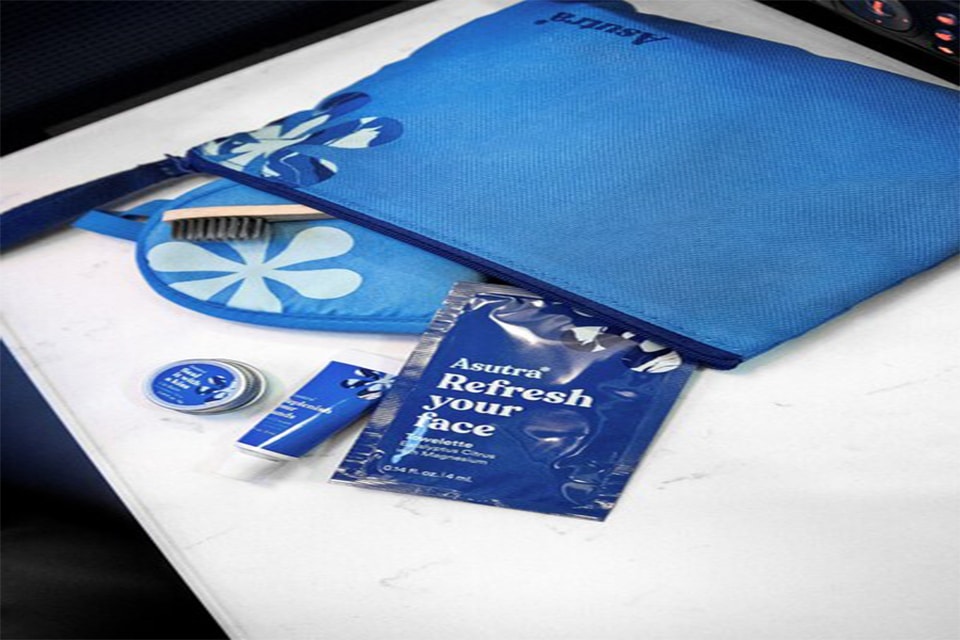Airlines
United’s New Transcontinental Amenity Kit Features Skincare Products

Beginning today, passengers traveling United Business® on the airline’s first-class domestic transcontinental itineraries will be the first to use new amenity packages that include unique goods from the health brand Asutra, which Venus Williams supports.
Additionally, the airline unveiled new amenity kits for United First passengers flying between the continental United States and Hawaii, which include skincare products from the Hawaiian company Ua Body that will make their onboard debut later this month. Approximately 65,000 travelers receive transcontinental and Hawaii amenity packs each month from United.
TSA agents find gun inside raw chicken at Florida airport(Opens in a new browser tab)
The new United premium transcontinental amenity packs, developed with Asutra, provide cruelty-free skincare products created without parabens, phthalates, or petroleum, and are intended to assist cross-country travelers relax and feel rejuvenated upon landing. An Asutra cleansing face towelette, nourishing lip balm, and hand lotion with magnesium are all included in each kit.
Additionally, mango seed butter, coconut oil, and almond oil are included to soothe, moisturize, and protect the skin while traveling. The kit also comes with a bamboo toothbrush, toothpaste, Asutra eye mask, and ear plugs to assist travellers to sleep while traveling. Everything is contained in a reusable Asutra pouch. A leaflet inside the pouch provides ideas for self-care practices, and the pouch and eye mask are produced from recyclable materials.

Christie Shinn, a local artist, created the artwork for the reusable Hawaii amenity pack pouch. In order to inspire and thrill visitors to the islands, the pouch, which is created from recycled materials, is available in four different designs that highlight the local topography.
These new amenity packs are just the most recent change United has made to improve the experience for passengers flying in its first-class cabins. New United First seats featuring wireless charging, vegan leather upholstery, Bluetooth connectivity, privacy screens, Italian quartzite cocktail tables, and an ergonomically designed cushion were introduced by the airline last month. Additionally, United recently launched additional clubs in Newark, Chicago, and Denver, with more to come. Additionally, United recently debuted new wines in United Polaris® and revived the United Polaris Sundae Cart.

Airlines
Air India Rolls Out A350s for Delhi-New York JFK and Newark Routes

In a major development for North American travelers, Air India has announced the deployment of its state-of-the-art Airbus A350-900 aircraft on two key routes: Delhi to New York and Delhi to Newark.
The service on the Delhi-New York route will commence on November 1, 2024, while the Delhi-Newark route will see its inaugural flight on January 2, 2025.
The introduction of the air india a350 will bring significant enhancements to Air India’s offerings, particularly with the launch of its Premium Economy class. air india retrofit This new class will feature 24 wide seats arranged in a 2-4-2 configuration, providing passengers with extra legroom and a more comfortable flying experience.
Soon, Air India aircraft will feature onboard WiFi & all-new cabins: Click here
“We are encouraged by the positive guest feedback we have received from the domestic deployment of our air india a350 interior to offer our hero product on the Delhi-New York JFK and Delhi-Newark routes. This is a significant leap forward for our U.S. operations that also underscores our commitment to continuous improvement,” said Campbell Wilson, Chief Executive Officer & Managing Director of Air India.
The A350’s Business class will set new standards with 28 private suites, each equipped with full-flat beds, direct aisle access, and personal wardrobes. Economy class will be configured to accommodate 264 passengers in a 3-4-3 layout. Across all cabins, passengers will enjoy the latest Panasonic eX3 in-flight entertainment system, offering over 2,200 hours of content.
Air India’s First A350-900: Interior, Routes, &Inflight Features: Click here
This strategic deployment marks a notable enhancement in Air India’s U.S. operations, with 60% of its flights to the U.S. now featuring new or upgraded cabin interiors. The air india new international routes currently operates 51 weekly flights to five U.S. destinations: New York JFK, Newark, Washington DC, Chicago, and San Francisco.
The revamped cabins, advanced in-flight entertainment systems, and improved service standards represent air india wifi commitment to providing a superior travel experience. “We believe this enhanced offering will solidify Air India’s position as a leading carrier and attract travellers seeking a world-class flying experience between India and the United States,” the airline stated.
Seats on these flights are now available for booking on Air India’s website, mobile app, and through travel agents, ensuring that passengers can easily plan their journeys on these newly upgraded routes.
Air India Economy vs Qatar airways economy: which is best?:Click here
-

 Travel1 week ago
Travel1 week agoAir India to Expand US Operations with Three New Routes After a Decade
-

 Travel2 weeks ago
Travel2 weeks agoWhy We Should Avoid These Stamps in a Passport
-

 Airlines1 month ago
Airlines1 month agoInvestigations Reveal Fake Chinese Titanium in Boeing and Airbus Jets
-

 Tech4 weeks ago
Tech4 weeks agoChina’s CATL Plans 1,800-Mile Electric Plane Launch by 2027
-

 Airport3 days ago
Airport3 days agoTop 10 Largest Airports in the World by Size
-

 Aerospace4 weeks ago
Aerospace4 weeks agoChina’s Fighter Jets Turn Wings into Autonomous Drones
-

 Airlines4 days ago
Airlines4 days agoAir India Rolls Out A350s for Delhi-New York JFK and Newark Routes
-

 Defence3 weeks ago
Defence3 weeks agoBoeing Enhances Chinook with New Engines and Block II Upgrades at $96 Million







